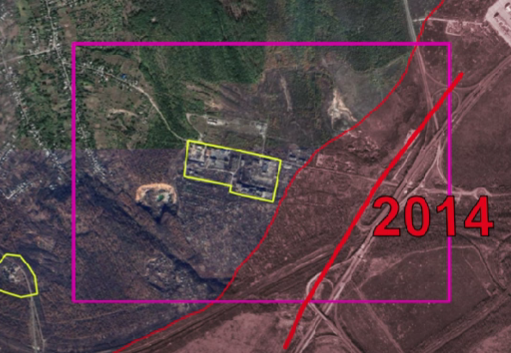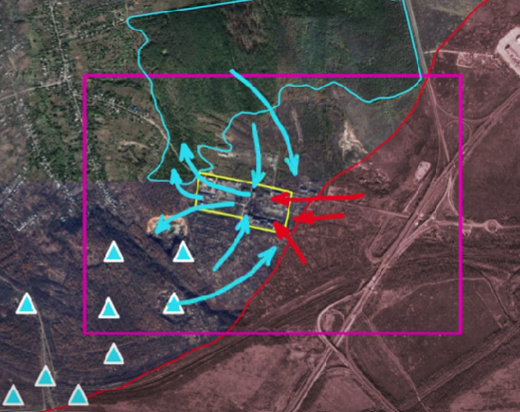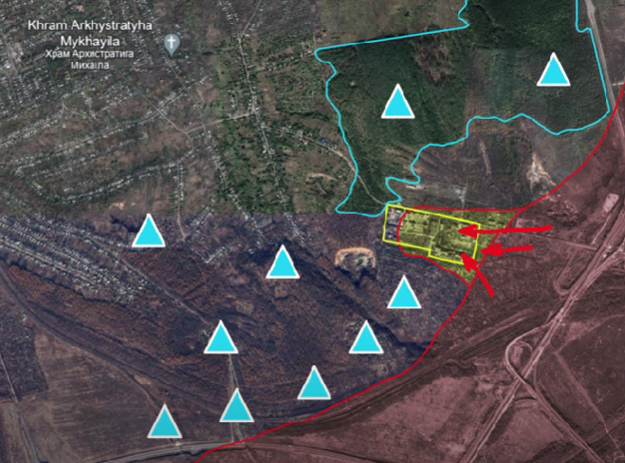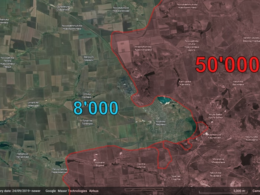Day 641
On 27 November, there were a lot of updates from the Avdiivka direction. After Russian forces conducted the first two massive waves of attacks on the Ukrainian flanks and did not achieve almost any results, the Russian command decided to focus on a completely different area, namely the southern part of the region.

Here, Russians predictably opened 2 vectors of attack along the highways: towards the “Tsarska Okhota” restaurant and a small industrial zone.

As described in one of the previous videos, the situation around the “Tsarska Okhota” restaurant was quite simple – Russians conducted head-on assaults on Ukrainian fortifications with remotely-controlled machine guns and were destroyed by them.
The latest updates suggest that Russians were pushed back from the embankment and now have to start the storming operation from the beginning.
The defense of the small industrial zone, however, had quite a few challenges. First of all, it is much closer to the initial contact line from 2014, so the battles in this region have been taking place for 10 years, which took a toll on the buildings and other Ukrainian fortifications in the area.

On top of that, Russian forces here were the closest to their main logistical center, so when Russian forces ramped up their offensive in this region, the sheer density of fire created a lot of problems for Ukrainians. Russian tanks would assume firing positions multiple km away from the Ukrainians and start to methodically destroy the buildings. The ruins slowly expanded the grey zone and gave more room for the Russian infantry.

Ukrainian fighters reported that Russians usually used platoon-sized assault units reinforced with tanks and armored fighting vehicles. When the outer edge of the industrial zone was levelled with the ground by Russian tanks, artillery, and aviation, the Ukrainian commanders reevaluated the situation and created a new plan. Ukrainians understood that staying there under constant fire was not productive, especially as the area was open and could be targeted from any side.
Moreover, Ukrainians completely control the small forest around the industrial zone, allowing them to accumulate forces while controlling the site from the north and northwest. Ukrainians also have a number of fortifications southwest of the industrial zone, so Ukrainians decided to leave the rubble, entice Russians to enter the empty ground, and attack Russians from three sides.

Shortly after that, Russian sources published footage showing how Ukrainian units were leaving the remnants for the industrial zone and claimed that Russian forces breached the Ukrainian defense and established total control over the plant. These claims were premature.
Once Russian forces started entering the industrial zone, they realized that there are virtually no shelters left to hide and establish a permanent presence because they destroyed it with artillery. Moreover, the Ukrainian special force hunted down the Russian artillery in the region. The footage shows the destruction of Grads and Msta-S systems from HIMARS, leaving the Russian vanguard with little fire support.
The decreased use of Russian artillery gave more freedom for the Ukrainian units to destroy everything that entered the territory of the plant. Ukrainian drone operators released dozens of videos of strikes and showed how the moment Russian mechanized units enter the region, they are getting hit with kamikaze drones.
A Ukrainian fighter said that Russian forces increased the number of troops by 5 times to capitalize on the capture of the ruins of the industrial zone, however, this only led to so many bodies scattered throughout the area that Russians did not even bother to start collecting them.
Some Russian analysts realized that this was a trap, and Russian forces made a huge mistake by entering the premises before securing their flanks and started criticizing the premature claims of Russian success. They said that no one should be celebrating anything because there are still small forests full of Ukrainians in the north, vineyards turned into extensive trench networks, the “Tsarska Okhota” restaurant and fortifications around it, the hamlet in between, and the former air defense base that surround the vulnerable Russian bridgehead.
Overall, the Ukrainian command was faced with a decision to either hold the ruins of the demolished buildings at a high cost to Ukrainians just to maintain the 2014 contact line or make a tactical retreat and force Russians to stay in the open under constant fire. Given that the southern part of Avdiivka has multiple lines of defense, Ukrainians were able to preserve their manpower without much damage to the strategic defense.
Moreover, by luring in Russian troops, Ukrainians managed to inflict disproportionately high losses on the enemy, and the number of Russian losses once again surpassed one thousand killed and wounded in one day, undermining their ability to continue launching assaults in this region.
In our daily frontline report, we pair up with the military blogger Reporting from Ukraine to keep you informed about what is happening on the battlefield in the Russo-Ukrainian war.
Read also:
- British intel: Russian casualties in Avdiivka among highest of war
- ISW: Recent attack on several Russian cities was a Ukraine’s military intelligence’s special operation
- Frontline report: Ukrainians disrupt Russia’s offensive north of Avdiivka, exploiting logistical weaknesses





